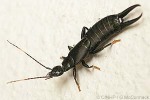Cook Islands Biodiversity Database
Species Page
Chelisoches morio
Karaunga (MG)Black Earwig
Multimedia & Additional Resources
| Type | Description | Download |
| Adult | 61KB | |
| Adult - pincers displayed | 51KB |
General Information
Cook Islands Distribution
| Southern Group: Present Makatea: | ||||||||
RR |
MG |
AT |
MK |
MT |
AK |
PL |
TK |
MN |
++++ |
P |
|||||||
| Northern Group: | |||||
TN |
MH |
RK |
PK |
NS |
SW |
+ |
++ |
||||
Scientific Taxonomy
Chelisoches morio (Fabricius, 1775)
SYNONYMS: Forficula morio [O]
TAXONOMY: ANIMALIA; ARTHROPODA; ATELOCERATA; HEXAPODA; INSECTA; PTERYGOTA; Dermaptera; CHELISOCHIDAE
More Information
GENERAL NOTE: For more than 1000 years there has been a persistent folklore that earwigs climb into human ears at night, and then penetrate the brain to lay their eggs! Rather a terrifying thought - certainly the stuff of nightmares. In fact, earwigs are mainly vegetarian, and they lay their eggs in the ground. They are not anymore likely to climb into a human ear than any other crawling insect. The name "earwig" is most likely a corruption of the Saxon "ear-wicga" (ear-insect or ear-creature), and the name probably referred to the ear-like wings of the insect. A less likely origin of the name is as a corruption of "ear-wing" referring to the same feature. Nevertheless the name "earwig" probably plays a part in maintain the myth that they have an affinity for human ears. [G.McCormack 12/2004]
Vouchers & References
Vouchers:
Pukapuka: fieldspecimen+photo, 2/2004, G.McCormack with ID as Chelisoches morio.
References:
Special Reference: Hudson, L. (1974) Dermaptera of Niue Island, and material from the Cook Islands. NZ J. Zool. 1(1):45-49.
Data Update History (information):
zTX, zB02, zM02, zupM04b, zD02
Web Resources
Citation Information
McCormack, Gerald (2007) Cook Islands Biodiversity Database, Version 2007.2. Cook Islands Natural Heritage Trust, Rarotonga. Online at http://cookislands.bishopmuseum.org. ![]()
Please refer to our use policy.

